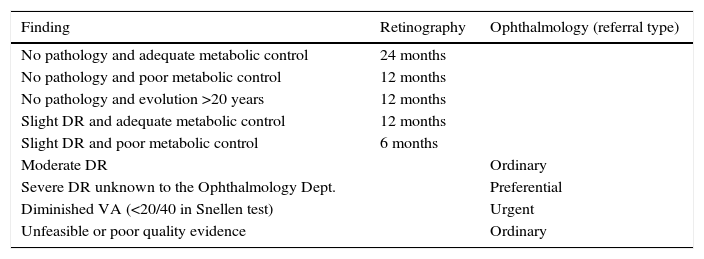To identify the prevalence and risk factors of diabetic retinopathy (DR) among rural inhabitants included in a tele-ophthalmology program. To analyze diagnostic accuracy among primary care physicians, concordance with ophthalmologists, and financial savings.
Material and methodsAn observational randomized study was conducted on 394 patients included in a tele-ophthalmology program (from January 2010 to January 2015). An analysis was performed on the clinical characteristics, DR findings in retinography images, and correspondence between the request for a second interpretation by an ophthalmologist, and previously established criteria for it: presence of moderate to severe DR, vision loss, poor image quality and/or intraocular pressure >22mmHg. Statistical analysis was performed using the SPSS program (Student t and χ2 tests).
ResultsDR prevalence was 12.1%. Patients with glycosylated hemoglobin values >7.68% or those treated with a combination of insulin and oral antidiabetic drugs showed a higher risk of DR (P<.05). 43.3% of patients correctly referred to ophthalmologists showed moderate to severe DR. Unnecessary referrals to specialists were improved from 91.7% in 2010 to 98.6% in 2014. It is estimated that the program has made a total saving of €152,550.45.
ConclusionsTele-ophthalmology programs are a useful tool in DR screening. Primary care physicians are able to distinguish patients who need specialist care, avoiding unnecessary referrals to ophthalmologists, and saving costs.
Estudiar la prevalencia de retinopatía diabética (RD) y los factores de riesgo asociados en la población incluida en un programa de teleoftalmología en área rural. Evaluar la capacidad diagnóstica de RD de los médicos de atención primaria (MAP) y su correcta coordinación con los oftalmólogos, cuantificando el ahorro generado.
Material y métodosEstudio observacional transversal de una muestra aleatoria de 394 pacientes incluidos en el programa de teleoftalmología desde enero de 2010 a enero de 2015. Analizamos características clínicas, hallazgos de RD en las retinografías y la correcta derivación de imágenes por los MAP al servicio de oftalmología según los criterios establecidos: RD moderada o severa, baja agudeza visual (AV), mala calidad de imagen y presión intraocular (PIO) >22mmHg. Análisis estadístico con SPSS. Pruebas t de Student y χ2.
ResultadosLa prevalencia de RD fue del 12,1%. Los pacientes con hemoglobina glucosilada >7,68% o tratados con combinación de antidiabéticos orales e insulina presentaron mayor riesgo de RD (p<0,05). El 43,3% de los pacientes derivados correctamente a oftalmología presentaban retinopatía moderada o severa. Los pacientes no derivados a oftalmología de forma correcta pasaron de un 91,7% en 2010 a un 98,6% en 2014. Estimamos un ahorro global de 152.550,45€.
ConclusionesEl programa de teleoftalmología resulta útil como cribado de RD. Los MAP son capaces de discriminar los pacientes que requieren valoración oftalmológica, evitando consultas presenciales y generando ahorro.







